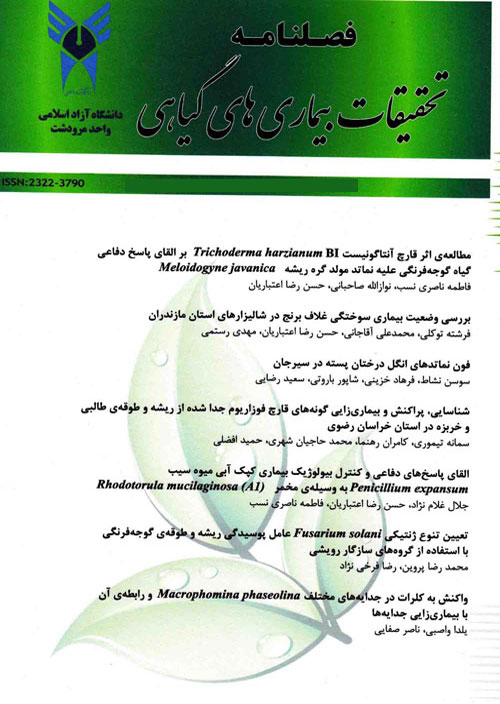Impact of drought stress on the growth parameters of tea sapling infected with Pratylenchus loosi and nematode population density
Abstract:
Root lesion nematode (Pratylenchus loosi Loof، 1960) is among the most damaging agents on tea plant in Iran. The nematode causes quality and quantity losses on tea crop. Most of tea plantations in Iran are under rain-fed conditions. In this research the impact of irrigation intervals (and consequently drought stress) and two types of soil texture، loamy-sandy and loamy-clay، on the population density of root lesion nematode and the growth indices of tea sapling were studied. Tea saplings of clone 100 were planted in pots 6000 cm3 containing either loamy-sandy or loamy-clay soil with population density of one nematode per g of soil. The pots were irrigated at 7، 14، 21 and 28 days intervals and some were left without irrigation as control. Pots were kept in the Tea-Research Station of Fashaalam for 8 months، during this period the required agronomic practices were done according to the routine of the region. After this period the saplings were harvested and in each experimental unit the growth indices such as height، total weight، root fresh weight، aerial fresh weight، aerial dry weight and root volume were measured. The nematode population density in soil and root were determined as well. The results of analysis of variance showed that all treatments had significant differences with each other. P. loosi could multiply well in treatments of 7 and 14 day irrigation intervals compared to treatments of 21 and 28 day and without irrigation. Nematode populations in root showed positive correlation with root volume and root weight at different irrigation intervals. Nematode population in soil and root were related too. The results of this survey showed that tea saplings with 7 and 14 day irrigation intervals could better tolerate the damage caused by P. loosi، in comparison to longer irrigation intervals and the treatment without irrigation. The nematode population density was higher in root and soil in loamy-sandy texture soil compared to loamy-clay soil This research revealed that in the treatments with 7 and 14 day irrigation intervals the water requirements of tea plants are met، consequently showing less damage in comparison with the other treatments with less water supply.
Keywords:
Language:
Persian
Published:
Research in Plant Pathology, Volume:1 Issue: 3, 2013
Pages:
41 to 50
magiran.com/p1208931
دانلود و مطالعه متن این مقاله با یکی از روشهای زیر امکان پذیر است:
اشتراک شخصی
با عضویت و پرداخت آنلاین حق اشتراک یکساله به مبلغ 1,390,000ريال میتوانید 70 عنوان مطلب دانلود کنید!
اشتراک سازمانی
به کتابخانه دانشگاه یا محل کار خود پیشنهاد کنید تا اشتراک سازمانی این پایگاه را برای دسترسی نامحدود همه کاربران به متن مطالب تهیه نمایند!
توجه!
- حق عضویت دریافتی صرف حمایت از نشریات عضو و نگهداری، تکمیل و توسعه مگیران میشود.
- پرداخت حق اشتراک و دانلود مقالات اجازه بازنشر آن در سایر رسانههای چاپی و دیجیتال را به کاربر نمیدهد.
In order to view content subscription is required
Personal subscription
Subscribe magiran.com for 70 € euros via PayPal and download 70 articles during a year.
Organization subscription
Please contact us to subscribe your university or library for unlimited access!




